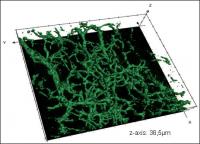
Three-dimensional reconstruction of a vascular system made of human endothelial cells in mice 20 days after injection of the spheroids. Image taken with a confocal microscope, stained green. The formation of new blood vessels, or angiogenesis, is an Achilles’ heel of tumor growth, because tumors depend on the supply of oxygen and nutrients for survival. Therefore, for some years now substances called angiogenesis inhibitors have been used in cancer treatment to suppress this process. In order to advance this new research field, a team of researchers headed by Professor Hellmut Augustin has developed a method to create a complex human vascular system in mice, which stays functional even after several months.
The method is based on the observation that isolated cells of the vessel walls, called endothelial cells, congregate spontaneously in cell cultures to form aggregates known as spheroids. “Individual endothelial cells floating in suspension are doomed to die – the association in spheroids stabilizes them,” says Hellmut Augustin. The scientists Abdullah Alajati and Anna Laib have been able to inject such spheroids, embedded in a gel matrix, under the skin of mice and to stimulate the formation of a network of human blood vessels by means of growth factors. The mice were genetically modified in such a way that their immune system was unable to reject the foreign cells. “The newly formed blood vessels are made exclusively of human endothelial cells,” explains Anna Laib, a young researcher at the DKFZ. “At the matrix borders the human endothelial cells establish contact with those of the mouse. In this way, the transplanted human vasculature gets connected to the blood circulation of the mouse.”
The method provides experimental freedom and may deliver answers to various questions of vascular biology research. Scientists can genetically manipulate the endothelial cells before transplantation in order to investigate the formation of vascular networks. In addition, it is possible to test the effect of pharmacological substances; the Freiburg-based company ProQinase GmbH, which is involved in the study, is already conducting such experiments. “The method is even interesting for the production of artificial tissues,” Hellmut Augustin says. “So far, one difficulty with the use of artificial replacement tissues has been to create a functioning vascular system that sufficiently supplies the tissue constructs.”
Source : Helmholtz Association of German Research Centres
 Print Article
Print Article Mail to a Friend
Mail to a Friend
